Evaluation of Healthcare Leadership Development Programmes
VerifiedAdded on 2020/05/28
|84
|15917
|53
AI Summary
The assignment entails a comprehensive evaluation of healthcare leadership development programmes using Kirkpatrick's four levels: reaction, learning, behaviour, and transfer of learning. Participants will complete questionnaires assessing their satisfaction with training, knowledge gained, behavioral changes post-training, and application of new skills in their roles. The goal is to analyze these aspects to determine the effectiveness of the programs in aligning with organizational objectives.
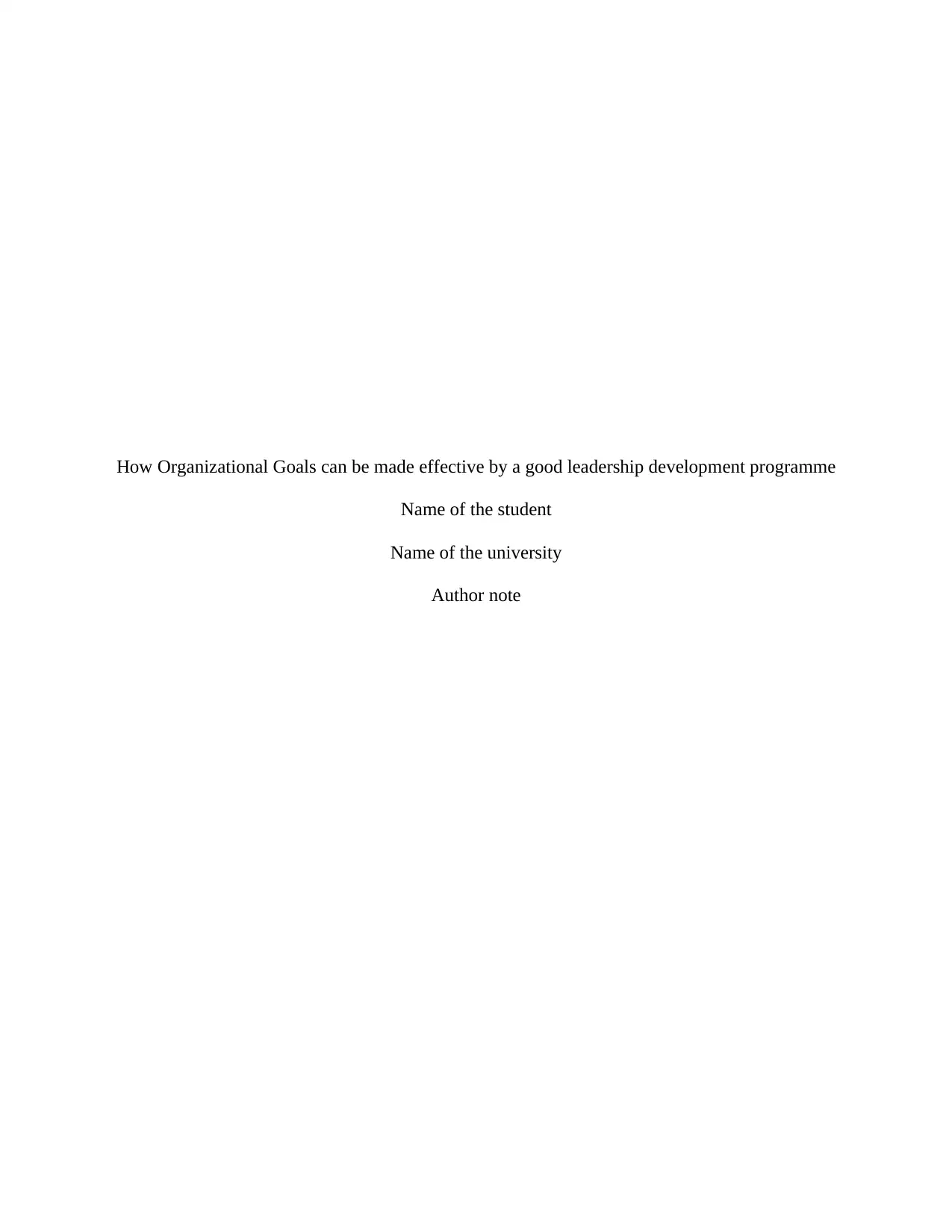
How Organizational Goals can be made effective by a good leadership development programme
Name of the student
Name of the university
Author note
Name of the student
Name of the university
Author note
Paraphrase This Document
Need a fresh take? Get an instant paraphrase of this document with our AI Paraphraser

Executive Summary
This research highlighted the impact of effective leadership program on achieving the
organizational goals. The organization selected for the study is National Health Services, which
is a public health service in United Kingdom. This research deals with the new programs that can
be developed by the organization so that they can mitigate their current issues. The literature
review shows that a good leader understand what their subordinates are doing and also
understands their situation by having in-depth knowledge of the working process. It is also found
from the literature review that these leaders should also gain trust with the employees and thus
have to develop effective interpersonal relationship. The literature used in the study have
emphasized on leadership approaches and the development programs. This study is an applied
research where a particular problem is addressed and the results in the study is aimed at assisting
the management to resolve issues they have been facing. In this study, pragmatism has been
chosen as the philosophy of research as it will determine the relevancy of each of the theories
and can consist of multiple theories. The research design is sequential explanatory, which
initially conducted quantitative data analysis and then the quantitative data was backed by
qualitative data to provide a different dimension to the study. In this study, both primary and
secondary data has been used. SPSS is the statistical tool used for examining the relationship
between the variables and developing respecting charts and graphs. In this study, quantitative
data has been collected from 140 employees of National Health Service and simple random
sampling has been used to select 50 respondents for selecting the overall population. Through the
data analysis, it has been found that the employees of the NHS do not use the Graduate
Management Training Scheme frequently as a result they lack the knowledge they require to
perform more effectively.
This research highlighted the impact of effective leadership program on achieving the
organizational goals. The organization selected for the study is National Health Services, which
is a public health service in United Kingdom. This research deals with the new programs that can
be developed by the organization so that they can mitigate their current issues. The literature
review shows that a good leader understand what their subordinates are doing and also
understands their situation by having in-depth knowledge of the working process. It is also found
from the literature review that these leaders should also gain trust with the employees and thus
have to develop effective interpersonal relationship. The literature used in the study have
emphasized on leadership approaches and the development programs. This study is an applied
research where a particular problem is addressed and the results in the study is aimed at assisting
the management to resolve issues they have been facing. In this study, pragmatism has been
chosen as the philosophy of research as it will determine the relevancy of each of the theories
and can consist of multiple theories. The research design is sequential explanatory, which
initially conducted quantitative data analysis and then the quantitative data was backed by
qualitative data to provide a different dimension to the study. In this study, both primary and
secondary data has been used. SPSS is the statistical tool used for examining the relationship
between the variables and developing respecting charts and graphs. In this study, quantitative
data has been collected from 140 employees of National Health Service and simple random
sampling has been used to select 50 respondents for selecting the overall population. Through the
data analysis, it has been found that the employees of the NHS do not use the Graduate
Management Training Scheme frequently as a result they lack the knowledge they require to
perform more effectively.

Table of content
Chapter 1..........................................................................................................................................5
1.0 Introduction................................................................................................................................5
1.1 Research Objective....................................................................................................................6
1.2 Research questions.....................................................................................................................6
1.3 Research Methodology..............................................................................................................6
1.4 Research Ethics..........................................................................................................................8
Chapter 2..........................................................................................................................................9
2.0 Literature Review......................................................................................................................9
2.1 Introduction................................................................................................................................9
2.2 Leadership................................................................................................................................10
2.3 Elements of Leadership...........................................................................................................11
2.4 Organizational Goals...............................................................................................................13
2.5 Factors Affecting Organizational Goals..................................................................................15
2.6 Impact of Leadership on Organizational Goals.......................................................................16
2.7 Leadership Development Programs.........................................................................................17
2.8 Impact of Leadership Development Programs on Organizational Goals................................19
2.9 Literature Gap..........................................................................................................................20
Chapter 3........................................................................................................................................21
Research Hypothesis......................................................................................................................21
Chapter 4........................................................................................................................................23
Methodology (Quantitative)..........................................................................................................23
4.1 Introduction..............................................................................................................................23
Chapter 1..........................................................................................................................................5
1.0 Introduction................................................................................................................................5
1.1 Research Objective....................................................................................................................6
1.2 Research questions.....................................................................................................................6
1.3 Research Methodology..............................................................................................................6
1.4 Research Ethics..........................................................................................................................8
Chapter 2..........................................................................................................................................9
2.0 Literature Review......................................................................................................................9
2.1 Introduction................................................................................................................................9
2.2 Leadership................................................................................................................................10
2.3 Elements of Leadership...........................................................................................................11
2.4 Organizational Goals...............................................................................................................13
2.5 Factors Affecting Organizational Goals..................................................................................15
2.6 Impact of Leadership on Organizational Goals.......................................................................16
2.7 Leadership Development Programs.........................................................................................17
2.8 Impact of Leadership Development Programs on Organizational Goals................................19
2.9 Literature Gap..........................................................................................................................20
Chapter 3........................................................................................................................................21
Research Hypothesis......................................................................................................................21
Chapter 4........................................................................................................................................23
Methodology (Quantitative)..........................................................................................................23
4.1 Introduction..............................................................................................................................23
⊘ This is a preview!⊘
Do you want full access?
Subscribe today to unlock all pages.

Trusted by 1+ million students worldwide
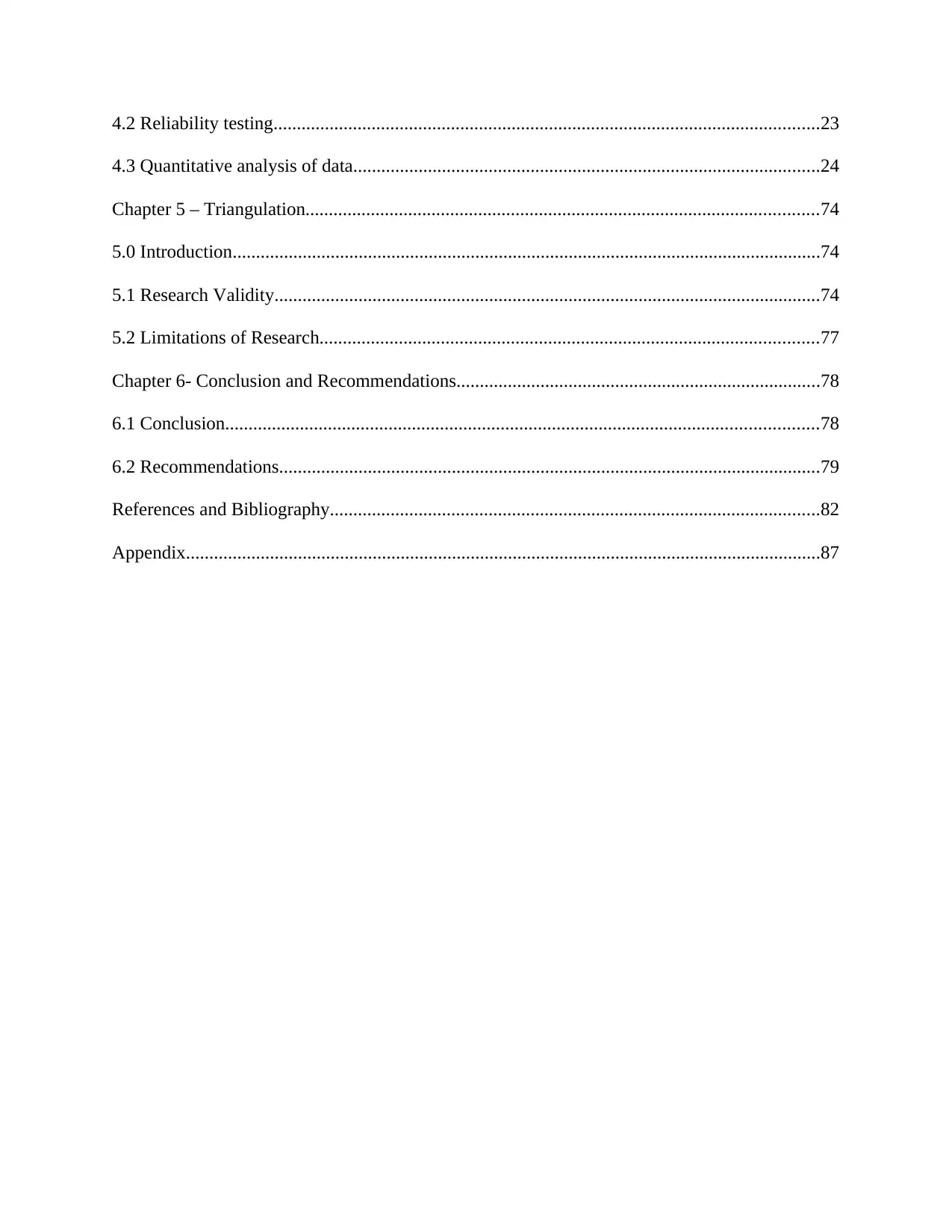
4.2 Reliability testing.....................................................................................................................23
4.3 Quantitative analysis of data....................................................................................................24
Chapter 5 – Triangulation..............................................................................................................74
5.0 Introduction..............................................................................................................................74
5.1 Research Validity.....................................................................................................................74
5.2 Limitations of Research...........................................................................................................77
Chapter 6- Conclusion and Recommendations..............................................................................78
6.1 Conclusion...............................................................................................................................78
6.2 Recommendations....................................................................................................................79
References and Bibliography.........................................................................................................82
Appendix........................................................................................................................................87
4.3 Quantitative analysis of data....................................................................................................24
Chapter 5 – Triangulation..............................................................................................................74
5.0 Introduction..............................................................................................................................74
5.1 Research Validity.....................................................................................................................74
5.2 Limitations of Research...........................................................................................................77
Chapter 6- Conclusion and Recommendations..............................................................................78
6.1 Conclusion...............................................................................................................................78
6.2 Recommendations....................................................................................................................79
References and Bibliography.........................................................................................................82
Appendix........................................................................................................................................87
Paraphrase This Document
Need a fresh take? Get an instant paraphrase of this document with our AI Paraphraser
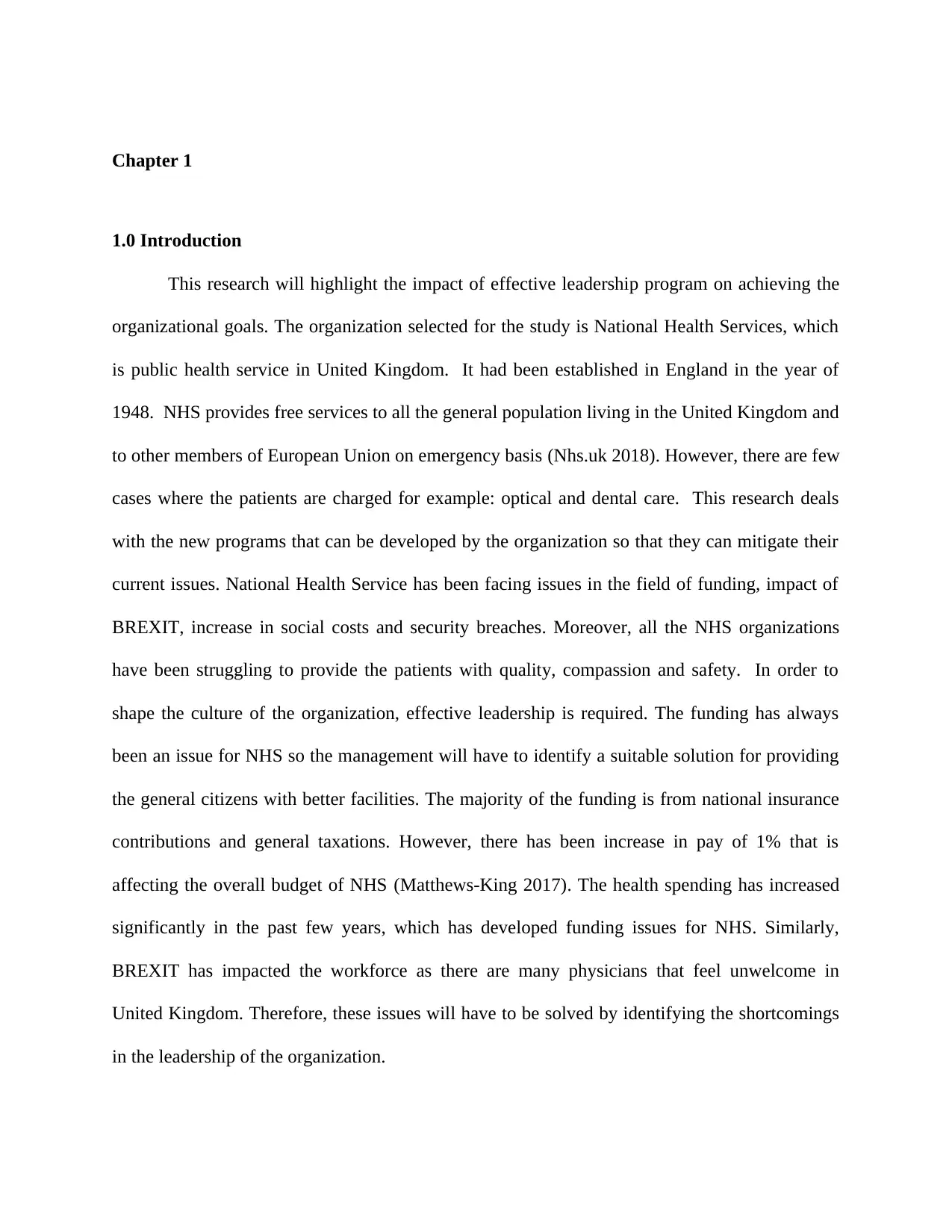
Chapter 1
1.0 Introduction
This research will highlight the impact of effective leadership program on achieving the
organizational goals. The organization selected for the study is National Health Services, which
is public health service in United Kingdom. It had been established in England in the year of
1948. NHS provides free services to all the general population living in the United Kingdom and
to other members of European Union on emergency basis (Nhs.uk 2018). However, there are few
cases where the patients are charged for example: optical and dental care. This research deals
with the new programs that can be developed by the organization so that they can mitigate their
current issues. National Health Service has been facing issues in the field of funding, impact of
BREXIT, increase in social costs and security breaches. Moreover, all the NHS organizations
have been struggling to provide the patients with quality, compassion and safety. In order to
shape the culture of the organization, effective leadership is required. The funding has always
been an issue for NHS so the management will have to identify a suitable solution for providing
the general citizens with better facilities. The majority of the funding is from national insurance
contributions and general taxations. However, there has been increase in pay of 1% that is
affecting the overall budget of NHS (Matthews-King 2017). The health spending has increased
significantly in the past few years, which has developed funding issues for NHS. Similarly,
BREXIT has impacted the workforce as there are many physicians that feel unwelcome in
United Kingdom. Therefore, these issues will have to be solved by identifying the shortcomings
in the leadership of the organization.
1.0 Introduction
This research will highlight the impact of effective leadership program on achieving the
organizational goals. The organization selected for the study is National Health Services, which
is public health service in United Kingdom. It had been established in England in the year of
1948. NHS provides free services to all the general population living in the United Kingdom and
to other members of European Union on emergency basis (Nhs.uk 2018). However, there are few
cases where the patients are charged for example: optical and dental care. This research deals
with the new programs that can be developed by the organization so that they can mitigate their
current issues. National Health Service has been facing issues in the field of funding, impact of
BREXIT, increase in social costs and security breaches. Moreover, all the NHS organizations
have been struggling to provide the patients with quality, compassion and safety. In order to
shape the culture of the organization, effective leadership is required. The funding has always
been an issue for NHS so the management will have to identify a suitable solution for providing
the general citizens with better facilities. The majority of the funding is from national insurance
contributions and general taxations. However, there has been increase in pay of 1% that is
affecting the overall budget of NHS (Matthews-King 2017). The health spending has increased
significantly in the past few years, which has developed funding issues for NHS. Similarly,
BREXIT has impacted the workforce as there are many physicians that feel unwelcome in
United Kingdom. Therefore, these issues will have to be solved by identifying the shortcomings
in the leadership of the organization.
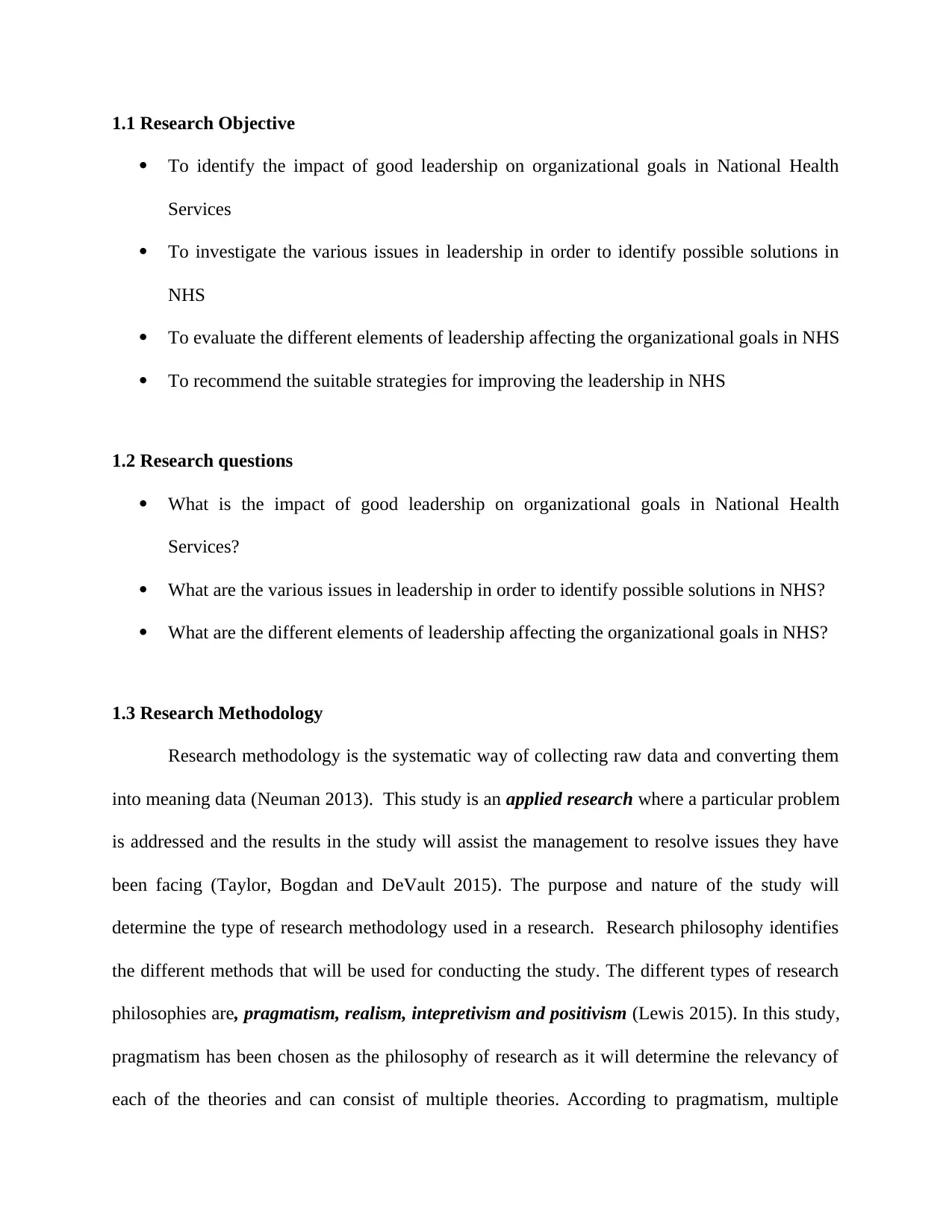
1.1 Research Objective
To identify the impact of good leadership on organizational goals in National Health
Services
To investigate the various issues in leadership in order to identify possible solutions in
NHS
To evaluate the different elements of leadership affecting the organizational goals in NHS
To recommend the suitable strategies for improving the leadership in NHS
1.2 Research questions
What is the impact of good leadership on organizational goals in National Health
Services?
What are the various issues in leadership in order to identify possible solutions in NHS?
What are the different elements of leadership affecting the organizational goals in NHS?
1.3 Research Methodology
Research methodology is the systematic way of collecting raw data and converting them
into meaning data (Neuman 2013). This study is an applied research where a particular problem
is addressed and the results in the study will assist the management to resolve issues they have
been facing (Taylor, Bogdan and DeVault 2015). The purpose and nature of the study will
determine the type of research methodology used in a research. Research philosophy identifies
the different methods that will be used for conducting the study. The different types of research
philosophies are, pragmatism, realism, intepretivism and positivism (Lewis 2015). In this study,
pragmatism has been chosen as the philosophy of research as it will determine the relevancy of
each of the theories and can consist of multiple theories. According to pragmatism, multiple
To identify the impact of good leadership on organizational goals in National Health
Services
To investigate the various issues in leadership in order to identify possible solutions in
NHS
To evaluate the different elements of leadership affecting the organizational goals in NHS
To recommend the suitable strategies for improving the leadership in NHS
1.2 Research questions
What is the impact of good leadership on organizational goals in National Health
Services?
What are the various issues in leadership in order to identify possible solutions in NHS?
What are the different elements of leadership affecting the organizational goals in NHS?
1.3 Research Methodology
Research methodology is the systematic way of collecting raw data and converting them
into meaning data (Neuman 2013). This study is an applied research where a particular problem
is addressed and the results in the study will assist the management to resolve issues they have
been facing (Taylor, Bogdan and DeVault 2015). The purpose and nature of the study will
determine the type of research methodology used in a research. Research philosophy identifies
the different methods that will be used for conducting the study. The different types of research
philosophies are, pragmatism, realism, intepretivism and positivism (Lewis 2015). In this study,
pragmatism has been chosen as the philosophy of research as it will determine the relevancy of
each of the theories and can consist of multiple theories. According to pragmatism, multiple
⊘ This is a preview!⊘
Do you want full access?
Subscribe today to unlock all pages.

Trusted by 1+ million students worldwide

realities can exist and there are multiple ways of interpreting and addressing an issue (Gray
2013).
Pragmatism will assist in using both quantitative and qualitative data for the given study.
The research design is sequential explanatory, which will initially conduct quantitative data
analysis and then the quantitative data will be backed by qualitative data to provide a different
dimension to the study. In this study, both primary and secondary data has been used. The
secondary data has been collected form journals, articles, websites links to form the literature
review whereas primary data has been collected to conduct the quantitative and qualitative
analysis of data. Quantitative analysis will consist of proving the hypothesis formulated in the
study by developed close-ended questions asked to the lower level employees of National Health
Services. This will consist of using statistical tools for identifying the frequency of the
respondents and using correlation and regression to identify the nature and degree of relationship
between the two variables. SPSS is the statistical tool used for examining the relationship
between the variables and developing respecting charts and graphs (Pallant 2013). Qualitative
analysis has been conducted by forming open-ended questionnaires asked to the managers of the
organizations. The patterns in their answers will be identified to collect data that will provide a
different dimension to the study. There are research approaches and they are inductive,
deductive and abductive. In this study, deductive approach will used to validate the theories
mentioned in the literature review.
Sampling is method of selecting population sample from the whole population (Levy and
Lemeshow 2013). As this study consist of mixed method both probabilistic sampling and non-
probabilistic sampling will be used. In this study, quantitative data has been collected from 140
employees of National Health Service and simple random sampling has been used to select 50
2013).
Pragmatism will assist in using both quantitative and qualitative data for the given study.
The research design is sequential explanatory, which will initially conduct quantitative data
analysis and then the quantitative data will be backed by qualitative data to provide a different
dimension to the study. In this study, both primary and secondary data has been used. The
secondary data has been collected form journals, articles, websites links to form the literature
review whereas primary data has been collected to conduct the quantitative and qualitative
analysis of data. Quantitative analysis will consist of proving the hypothesis formulated in the
study by developed close-ended questions asked to the lower level employees of National Health
Services. This will consist of using statistical tools for identifying the frequency of the
respondents and using correlation and regression to identify the nature and degree of relationship
between the two variables. SPSS is the statistical tool used for examining the relationship
between the variables and developing respecting charts and graphs (Pallant 2013). Qualitative
analysis has been conducted by forming open-ended questionnaires asked to the managers of the
organizations. The patterns in their answers will be identified to collect data that will provide a
different dimension to the study. There are research approaches and they are inductive,
deductive and abductive. In this study, deductive approach will used to validate the theories
mentioned in the literature review.
Sampling is method of selecting population sample from the whole population (Levy and
Lemeshow 2013). As this study consist of mixed method both probabilistic sampling and non-
probabilistic sampling will be used. In this study, quantitative data has been collected from 140
employees of National Health Service and simple random sampling has been used to select 50
Paraphrase This Document
Need a fresh take? Get an instant paraphrase of this document with our AI Paraphraser

respondents for selecting the overall population. Therefore, randomization is the basis of
sampling which provides equal opportunity to all the participants of being selected. On the other
hand, qualitative analysis has been conducted on 5 managers of Nation Health Service so non-
probabilistic sampling has been used as the sample size is small and difficult to find participants.
In order to keep high validity and reliability in the study, pilot test has been conducted where
sample questionnaires were sent out to 20 respondents. Moreover, the data has been collected
multiple times and test rated reliability is used to examine if the results were using the same
methodology.
1.4 Research Ethics
Research ethics is the appropriateness of the methods used by the researcher for
executing the study (Battiste 2016). The anonymity of the respondents has been maintained and
none of their personal data has been revealed. The data collected in the study has not been used
for any other purpose. The respondents were made aware of the purpose of the study so none of
them were strained to take part in the survey. The respondents have participated of their own
desire and none of the data used in the study has been manipulated to reach a desired result.
sampling which provides equal opportunity to all the participants of being selected. On the other
hand, qualitative analysis has been conducted on 5 managers of Nation Health Service so non-
probabilistic sampling has been used as the sample size is small and difficult to find participants.
In order to keep high validity and reliability in the study, pilot test has been conducted where
sample questionnaires were sent out to 20 respondents. Moreover, the data has been collected
multiple times and test rated reliability is used to examine if the results were using the same
methodology.
1.4 Research Ethics
Research ethics is the appropriateness of the methods used by the researcher for
executing the study (Battiste 2016). The anonymity of the respondents has been maintained and
none of their personal data has been revealed. The data collected in the study has not been used
for any other purpose. The respondents were made aware of the purpose of the study so none of
them were strained to take part in the survey. The respondents have participated of their own
desire and none of the data used in the study has been manipulated to reach a desired result.
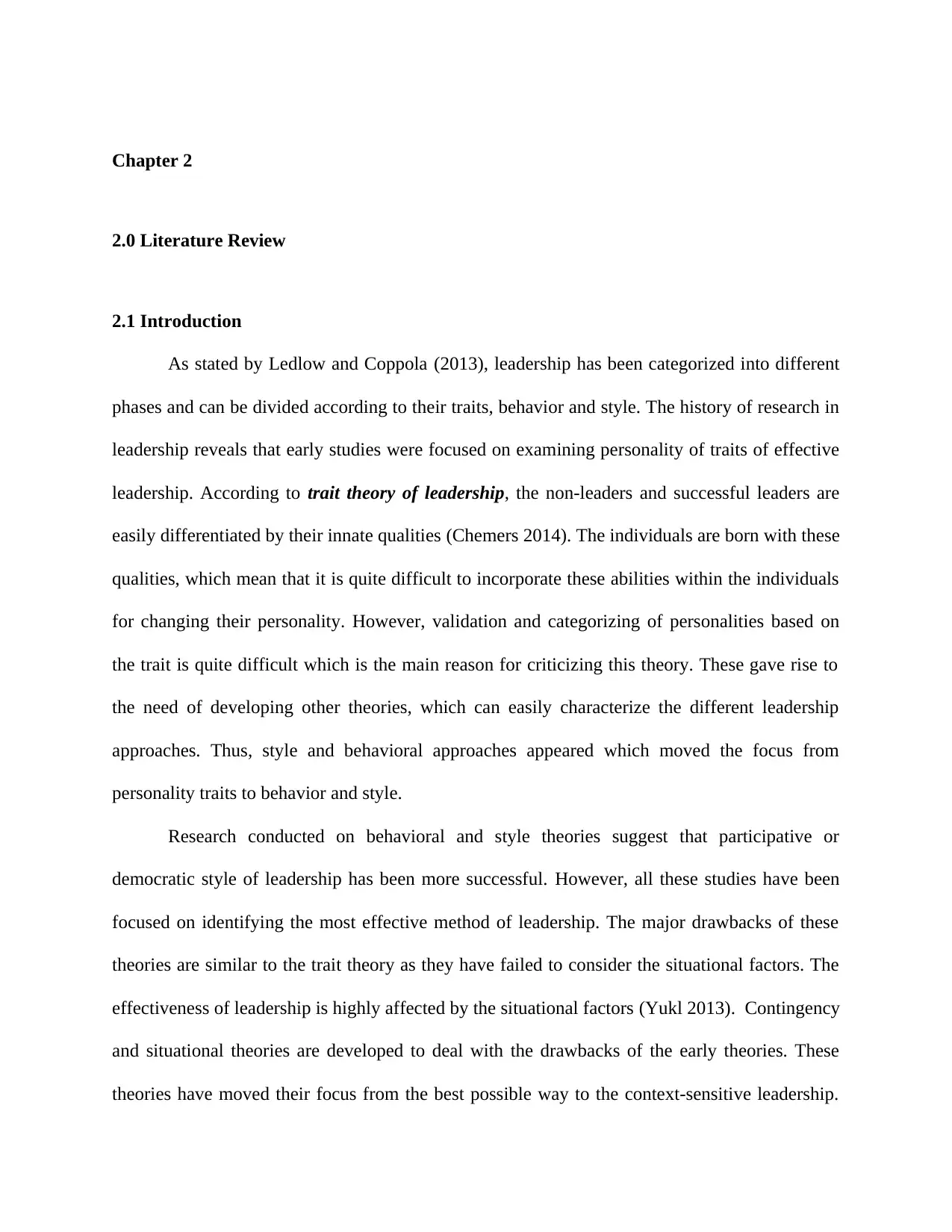
Chapter 2
2.0 Literature Review
2.1 Introduction
As stated by Ledlow and Coppola (2013), leadership has been categorized into different
phases and can be divided according to their traits, behavior and style. The history of research in
leadership reveals that early studies were focused on examining personality of traits of effective
leadership. According to trait theory of leadership, the non-leaders and successful leaders are
easily differentiated by their innate qualities (Chemers 2014). The individuals are born with these
qualities, which mean that it is quite difficult to incorporate these abilities within the individuals
for changing their personality. However, validation and categorizing of personalities based on
the trait is quite difficult which is the main reason for criticizing this theory. These gave rise to
the need of developing other theories, which can easily characterize the different leadership
approaches. Thus, style and behavioral approaches appeared which moved the focus from
personality traits to behavior and style.
Research conducted on behavioral and style theories suggest that participative or
democratic style of leadership has been more successful. However, all these studies have been
focused on identifying the most effective method of leadership. The major drawbacks of these
theories are similar to the trait theory as they have failed to consider the situational factors. The
effectiveness of leadership is highly affected by the situational factors (Yukl 2013). Contingency
and situational theories are developed to deal with the drawbacks of the early theories. These
theories have moved their focus from the best possible way to the context-sensitive leadership.
2.0 Literature Review
2.1 Introduction
As stated by Ledlow and Coppola (2013), leadership has been categorized into different
phases and can be divided according to their traits, behavior and style. The history of research in
leadership reveals that early studies were focused on examining personality of traits of effective
leadership. According to trait theory of leadership, the non-leaders and successful leaders are
easily differentiated by their innate qualities (Chemers 2014). The individuals are born with these
qualities, which mean that it is quite difficult to incorporate these abilities within the individuals
for changing their personality. However, validation and categorizing of personalities based on
the trait is quite difficult which is the main reason for criticizing this theory. These gave rise to
the need of developing other theories, which can easily characterize the different leadership
approaches. Thus, style and behavioral approaches appeared which moved the focus from
personality traits to behavior and style.
Research conducted on behavioral and style theories suggest that participative or
democratic style of leadership has been more successful. However, all these studies have been
focused on identifying the most effective method of leadership. The major drawbacks of these
theories are similar to the trait theory as they have failed to consider the situational factors. The
effectiveness of leadership is highly affected by the situational factors (Yukl 2013). Contingency
and situational theories are developed to deal with the drawbacks of the early theories. These
theories have moved their focus from the best possible way to the context-sensitive leadership.
⊘ This is a preview!⊘
Do you want full access?
Subscribe today to unlock all pages.

Trusted by 1+ million students worldwide

According to the contingency theory of leadership, it can be stated that the adaptability of the
leadership style is important in making the leadership effective (Waters 2013). Therefore, there
is no best way of leadership and the leadership style of individuals change depending upon the
situational factors. Moreover, it is essential to keep a balance between the different leadership
approaches so that all the situations can be dealt in an effective manner. Therefore, appropriate
styles are developed to deal with the different circumstances within an organization.
Transformational and transactional styles of leadership are developed from these theories,
which show both importance of using both the aspect. Effective leadership is the most crucial
determinant of organization failure and success. As stated by Bryman (2013), effective
leadership will be able to deal with all the market uncertainties and reach the organizational
goals.
2.2 Leadership
The huge, largely raging changes that where a part of the characteristics of the business
organizations back in the 1970s and 1980s directed towards the concept of the “new paradigm”,
emphasizing mostly on the traits of being charismatic, transformational and visionary. These
traits were seen as identifiers of the conception of the leader being a person who describes
organizational reality by means of defining the mission and values of any organization that
would be supportive. Hence, inside the latest leadership approach, leaders are viewed as the
managers of meaning, instead of being just an influence process. Over the past decade the swift
changes experienced all over the world have asked for the development of effective leadership
skills, especially in terms of achieving the organizational goals. As a result of that, organizations
started giving increasing priority to different leadership development programs (Koech and
Namusonge 2012).
leadership style is important in making the leadership effective (Waters 2013). Therefore, there
is no best way of leadership and the leadership style of individuals change depending upon the
situational factors. Moreover, it is essential to keep a balance between the different leadership
approaches so that all the situations can be dealt in an effective manner. Therefore, appropriate
styles are developed to deal with the different circumstances within an organization.
Transformational and transactional styles of leadership are developed from these theories,
which show both importance of using both the aspect. Effective leadership is the most crucial
determinant of organization failure and success. As stated by Bryman (2013), effective
leadership will be able to deal with all the market uncertainties and reach the organizational
goals.
2.2 Leadership
The huge, largely raging changes that where a part of the characteristics of the business
organizations back in the 1970s and 1980s directed towards the concept of the “new paradigm”,
emphasizing mostly on the traits of being charismatic, transformational and visionary. These
traits were seen as identifiers of the conception of the leader being a person who describes
organizational reality by means of defining the mission and values of any organization that
would be supportive. Hence, inside the latest leadership approach, leaders are viewed as the
managers of meaning, instead of being just an influence process. Over the past decade the swift
changes experienced all over the world have asked for the development of effective leadership
skills, especially in terms of achieving the organizational goals. As a result of that, organizations
started giving increasing priority to different leadership development programs (Koech and
Namusonge 2012).
Paraphrase This Document
Need a fresh take? Get an instant paraphrase of this document with our AI Paraphraser
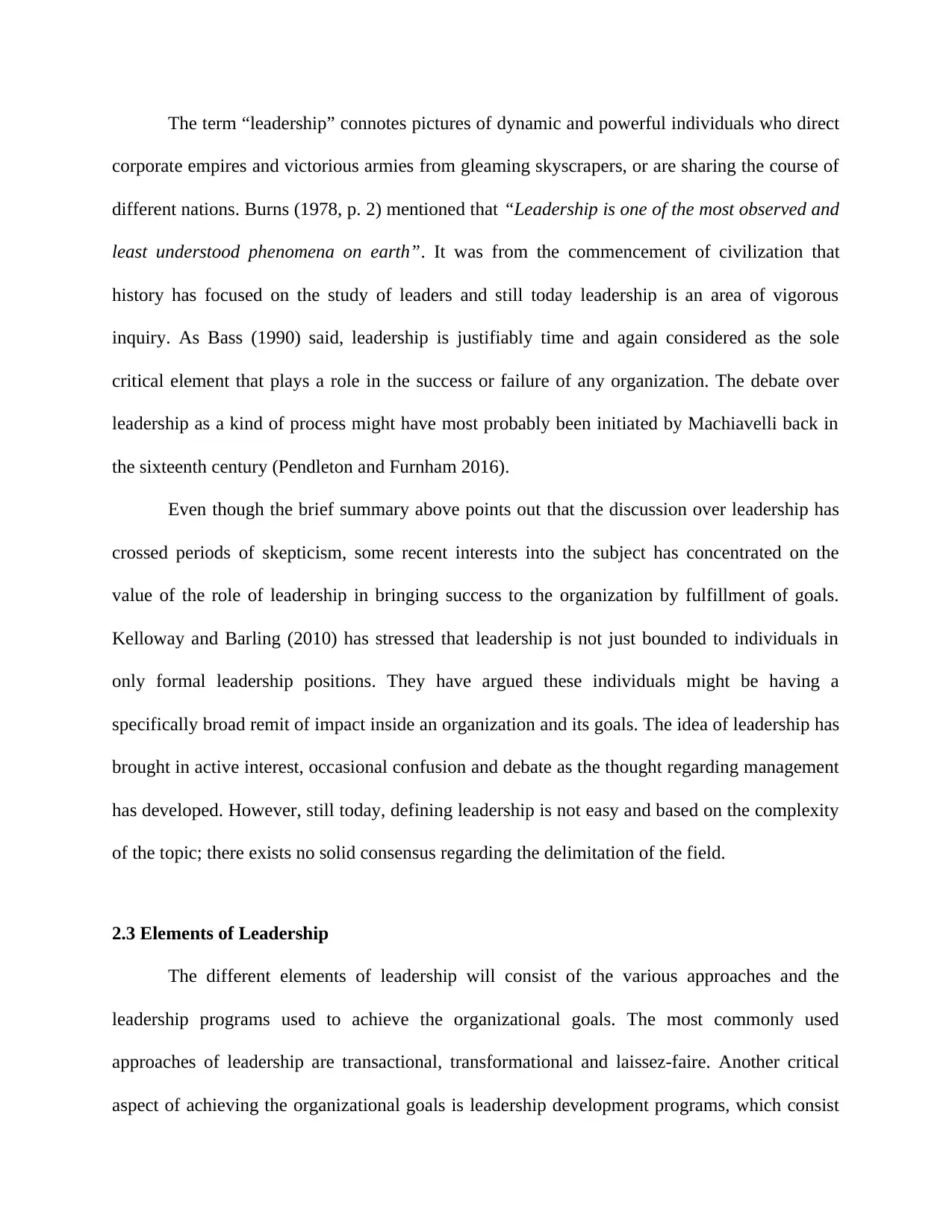
The term “leadership” connotes pictures of dynamic and powerful individuals who direct
corporate empires and victorious armies from gleaming skyscrapers, or are sharing the course of
different nations. Burns (1978, p. 2) mentioned that “Leadership is one of the most observed and
least understood phenomena on earth”. It was from the commencement of civilization that
history has focused on the study of leaders and still today leadership is an area of vigorous
inquiry. As Bass (1990) said, leadership is justifiably time and again considered as the sole
critical element that plays a role in the success or failure of any organization. The debate over
leadership as a kind of process might have most probably been initiated by Machiavelli back in
the sixteenth century (Pendleton and Furnham 2016).
Even though the brief summary above points out that the discussion over leadership has
crossed periods of skepticism, some recent interests into the subject has concentrated on the
value of the role of leadership in bringing success to the organization by fulfillment of goals.
Kelloway and Barling (2010) has stressed that leadership is not just bounded to individuals in
only formal leadership positions. They have argued these individuals might be having a
specifically broad remit of impact inside an organization and its goals. The idea of leadership has
brought in active interest, occasional confusion and debate as the thought regarding management
has developed. However, still today, defining leadership is not easy and based on the complexity
of the topic; there exists no solid consensus regarding the delimitation of the field.
2.3 Elements of Leadership
The different elements of leadership will consist of the various approaches and the
leadership programs used to achieve the organizational goals. The most commonly used
approaches of leadership are transactional, transformational and laissez-faire. Another critical
aspect of achieving the organizational goals is leadership development programs, which consist
corporate empires and victorious armies from gleaming skyscrapers, or are sharing the course of
different nations. Burns (1978, p. 2) mentioned that “Leadership is one of the most observed and
least understood phenomena on earth”. It was from the commencement of civilization that
history has focused on the study of leaders and still today leadership is an area of vigorous
inquiry. As Bass (1990) said, leadership is justifiably time and again considered as the sole
critical element that plays a role in the success or failure of any organization. The debate over
leadership as a kind of process might have most probably been initiated by Machiavelli back in
the sixteenth century (Pendleton and Furnham 2016).
Even though the brief summary above points out that the discussion over leadership has
crossed periods of skepticism, some recent interests into the subject has concentrated on the
value of the role of leadership in bringing success to the organization by fulfillment of goals.
Kelloway and Barling (2010) has stressed that leadership is not just bounded to individuals in
only formal leadership positions. They have argued these individuals might be having a
specifically broad remit of impact inside an organization and its goals. The idea of leadership has
brought in active interest, occasional confusion and debate as the thought regarding management
has developed. However, still today, defining leadership is not easy and based on the complexity
of the topic; there exists no solid consensus regarding the delimitation of the field.
2.3 Elements of Leadership
The different elements of leadership will consist of the various approaches and the
leadership programs used to achieve the organizational goals. The most commonly used
approaches of leadership are transactional, transformational and laissez-faire. Another critical
aspect of achieving the organizational goals is leadership development programs, which consist
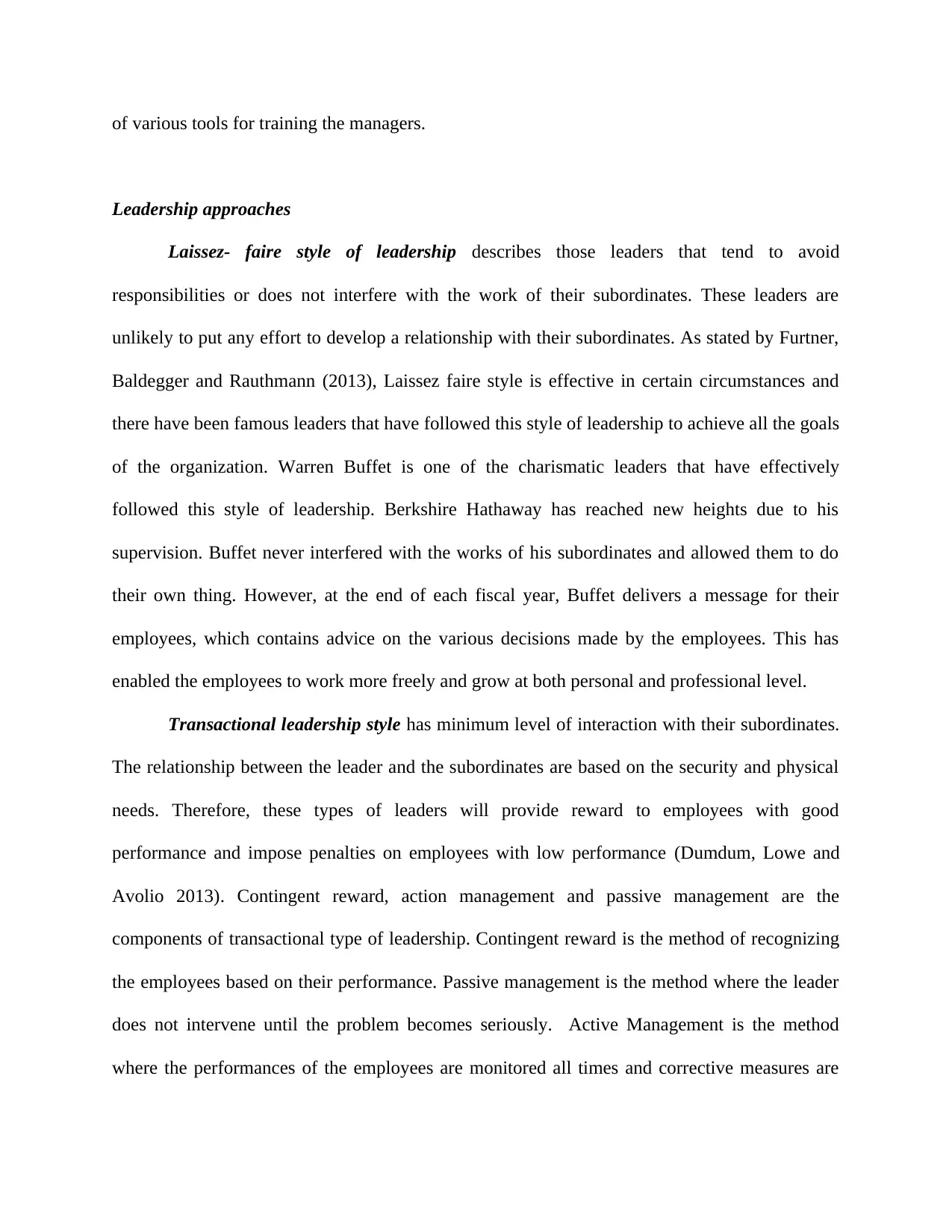
of various tools for training the managers.
Leadership approaches
Laissez- faire style of leadership describes those leaders that tend to avoid
responsibilities or does not interfere with the work of their subordinates. These leaders are
unlikely to put any effort to develop a relationship with their subordinates. As stated by Furtner,
Baldegger and Rauthmann (2013), Laissez faire style is effective in certain circumstances and
there have been famous leaders that have followed this style of leadership to achieve all the goals
of the organization. Warren Buffet is one of the charismatic leaders that have effectively
followed this style of leadership. Berkshire Hathaway has reached new heights due to his
supervision. Buffet never interfered with the works of his subordinates and allowed them to do
their own thing. However, at the end of each fiscal year, Buffet delivers a message for their
employees, which contains advice on the various decisions made by the employees. This has
enabled the employees to work more freely and grow at both personal and professional level.
Transactional leadership style has minimum level of interaction with their subordinates.
The relationship between the leader and the subordinates are based on the security and physical
needs. Therefore, these types of leaders will provide reward to employees with good
performance and impose penalties on employees with low performance (Dumdum, Lowe and
Avolio 2013). Contingent reward, action management and passive management are the
components of transactional type of leadership. Contingent reward is the method of recognizing
the employees based on their performance. Passive management is the method where the leader
does not intervene until the problem becomes seriously. Active Management is the method
where the performances of the employees are monitored all times and corrective measures are
Leadership approaches
Laissez- faire style of leadership describes those leaders that tend to avoid
responsibilities or does not interfere with the work of their subordinates. These leaders are
unlikely to put any effort to develop a relationship with their subordinates. As stated by Furtner,
Baldegger and Rauthmann (2013), Laissez faire style is effective in certain circumstances and
there have been famous leaders that have followed this style of leadership to achieve all the goals
of the organization. Warren Buffet is one of the charismatic leaders that have effectively
followed this style of leadership. Berkshire Hathaway has reached new heights due to his
supervision. Buffet never interfered with the works of his subordinates and allowed them to do
their own thing. However, at the end of each fiscal year, Buffet delivers a message for their
employees, which contains advice on the various decisions made by the employees. This has
enabled the employees to work more freely and grow at both personal and professional level.
Transactional leadership style has minimum level of interaction with their subordinates.
The relationship between the leader and the subordinates are based on the security and physical
needs. Therefore, these types of leaders will provide reward to employees with good
performance and impose penalties on employees with low performance (Dumdum, Lowe and
Avolio 2013). Contingent reward, action management and passive management are the
components of transactional type of leadership. Contingent reward is the method of recognizing
the employees based on their performance. Passive management is the method where the leader
does not intervene until the problem becomes seriously. Active Management is the method
where the performances of the employees are monitored all times and corrective measures are
⊘ This is a preview!⊘
Do you want full access?
Subscribe today to unlock all pages.

Trusted by 1+ million students worldwide
1 out of 84
Related Documents
Your All-in-One AI-Powered Toolkit for Academic Success.
+13062052269
info@desklib.com
Available 24*7 on WhatsApp / Email
![[object Object]](/_next/static/media/star-bottom.7253800d.svg)
Unlock your academic potential
Copyright © 2020–2025 A2Z Services. All Rights Reserved. Developed and managed by ZUCOL.





